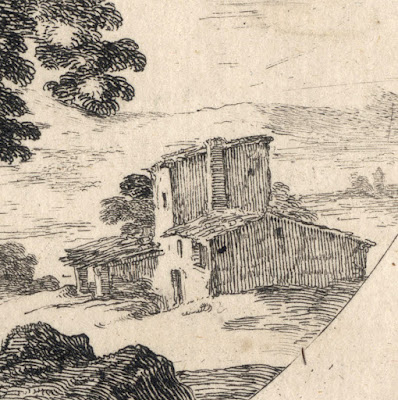Stefano
della Bella (1610–1664)
“Travellers in a landscape” (Rijksmuseum title), 1656, from the
series of six plates, “Landscapes and Harbours”.
Etching on laid paper trimmed with small margins and remargined
with a support sheet.
Size: (remargined support sheet) 32.5 x 29.9 cm; (sheet) 14.4 x
14.7 cm; (plate) 13.7 x 14.2 cm; (diameter of circular image borderline) 13.4
cm
Lettered on the plate at lower left edge: "Stef. Della Bella
fecit. 1656."
De Vesme/Massar 1971 743.II (A.de Vesme 1971, revised by Phyllis
D.Massar, “Stefano della Bella”, New York, p. 113, cat. no. 743); Jombert
(Della Bella) 188-1 (Charles Antoine Jombert 1772, “Essai d'un catalogue de
l'oeuvre d'Etienne de la Belle, peintre et graveur florentin”, Paris, p. 183,
cat. no. 188–1)
The British Museum offers the following description of this print:
“Landscape; a woman riding a horse and a man carrying a bundle, at
centre, travelling towards background, with a rustic house behind to right in a
plain and a large chestnut tree at front left; a round composition.” (http://www.britishmuseum.org/research/collection_online/collection_object_details.aspx?objectId=1499102&partId=1&searchText=della+bella&page=1)
The Rijksmuseum offers the following description of this print:
“A woman on horseback and a running man with a knapsack in a
landscape. Front left an old chestnut tree. In the background on the right a
house.”
Condition: crisp, well-inked and well-printed impression in very
good condition (i.e. there are no tears, holes, abrasions, but with a few minor
marks/signs of handling) with small margins (approx. 3mm) and remargined with
an archival support sheet of millennium quality washi paper.
I am selling this round formatted image revealing Della Bella’s early
leaning towards the Rocco style for AU$146 in total (currently US$112.28/EUR91.57/GBP80.26
at the time of posting this listing) including postage and handling to anywhere
in the world.
If you are interested in purchasing this light-filled composition
with travellers, please contact me (oz_jim@printsandprinciples.com) and I will
send you a PayPal invoice to make the payment easy.
This print has been sold
Sometimes what may seem like a straightforward simple landscape
composition has a layering of meanings that makes it special. From my
standpoint this is certainly the case with this socially inoffensive and almost
decoratively lovely image.
When I look at these travellers portrayed half-concealed from the
viewer as they descend from the foreground ridge towards what the British
Museum describes as “rustic house” in the middle distance, I am reminded that
images of such innocent travellers may have held a curiously interesting
meaning for Della Bella. What I am referring to here is the artist’s fellow printmaker,
Salvator Rosa, who—perhaps more in myth than in fact—is scandalously rumoured
to have engaged with bandits (banditti)
preying upon such travellers. Whether or not such ideas were even in Della
Bella’s mind at the time of executing this image, I really don’t know.
Nevertheless, his choice to feature travellers without
doubt carries with it the many issues underpinning his contemporaries’ choice
to also include travellers in their landscapes, such as Herman van Swanevelt
and Jan Both.
Beyond such hidden meanings, looking at the composition itself, I sense
an artist torn between the desire to express the dynamic energy of twisting
natural forms and a passion for flat tonal patterns. In terms of Della Bella’s
interest in expressing dynamic energy, note the strong flow of modelling marks
giving form to the foreground tree trunk. In contrast with the strong
directional rhythms of these marks, Della Bella has juxtaposed the contour
strokes describing the trunk and branches with relatively flat tonal patterning
of foliage textures.
Interestingly, at the time of executing this print the artist had
begun to explore ways to replicate in his etchings the broad planes found in
his watercolour washes. Although Della Bella did not discover aquatint—that was
a technique introduced by Jan van de Velde IV around 1650—Della Bella
experimented with a cruder technique of laying dilute washes of acid to flat
bite some of his later prints with delicate tonal areas.








No comments:
Post a Comment
Please let me know your thoughts, advice about inaccuracies (including typos) and additional information that you would like to add to any post.